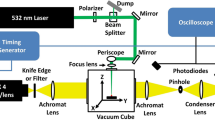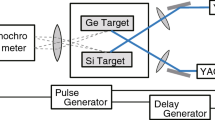Abstract
This study describes experimental work examining the critical energy for direct initiation of detonation by laser ablation in a stoichiometric acetylene–oxygen mixture. The amount of input energy, the target material, and the surface roughness of the target were varied to study their effects on shock wave generation. Aluminum and stainless steel were used as target materials. The propagating shock wave induced by laser ablation was observed using high-speed shadow imaging. The critical energy for direct initiation of detonation was calculated using the strong blast wave theory. The critical input energy for aluminum was found to be lower than that for stainless steel. Because the thermodynamic critical temperature of aluminum is lower than that of stainless steel, aluminum caused a phase explosion more easily than stainless steel, thus resulting in direct initiation of detonation with a lower amount of input energy. The effects of surface roughness on critical input energy and shock wave generation were negligibly small. The critical initiation energy was estimated to be \(10.3 \pm 0.2\) mJ, which is in agreement with the experimental data obtained in previous work. The estimated critical initiation energy was independent of the target material. However, other predictions of the critical initiation energy by using the cell size overestimated this value because of the scatter in cell size data of an unstable cellular structure. Furthermore, interaction between plasma plumes formed by laser ablation and those formed by breakdown near the target surface might have contributed to requiring a lower amount of energy for initiating detonation.








Similar content being viewed by others
References
Bussing, T., Pappas, G.: An introduction to pulse detonation engines. AIAA Paper, 94-0263. (1994)
Kindracki, J., Wolanski, P., Gut, Z.: Experimental research on the rotating detonation in gaseous fuels–oxygen mixtures. Shock Waves 21, 75–84 (2011)
Bach, G.G., Knystautas, R., Lee, J.H.: Initiation criteria fir diverging gaseous detonations. In: Proceedings of the 13th Symposium on Combustion, pp. 1097–1110 (1971)
Edwards, D.H., Hooper, G., Morgan, J.M., Thomas, G.O.: The quasi-steady regime in critically initiated detonation waves. J. Phys. D. Appl. Phys. 11, 2103–2117 (1978)
Zhang, B., Ng, H.D., Lee, J.H.S.: Measurement and scaling analysis of critical energy for direct initiation of gaseous detonations. Shock Waves 22, 275–279 (2012)
Semerok, A., Chaléard, C., Detalle, V., Lacour, J.-L., Mauchien, P., Meynadier, P., Nouvellon, C., Sallé, B., Palianov, P., Perdrix, M., Petite, G.: Experimental investigations of laser ablation efficiency of pure metals with femto, pico and nanosecond pulses. Appl. Surf. Sci. 138–139, 311–314 (1999)
Mori, K., Kusaka, K., Fujita, K., Niino, M.: Ignition characteristics of \({\rm GH}_{2}\)/\({\rm GO}_{x}\) mixture using laser ablation ignition. Trans. Jpn. Soc. Mech. Eng. 46, 121–126 (2003)
Kataoka, H., Kato, H., Ishii, K.: Direct initiation of acetylene–oxygen mixture using laser ablation. In: Proceedings of the 22nd International Colloqium on the Dynamics of Explosions and Reactive Systems, Paper No. 198. Minsk, Belarus (2009)
Kataoka, H., Kato, H., Suzuki, K., Ishihara, S., Ishii, K., Segawa, D.: Effects of target position on direct initiation of detonation using laser ablation. Trans. Jpn. Soc. Aero. Space. Sci. 58, 313–318 (2015)
Taylor, G.: The formation of a blast wave by a very intense explosion. Proc. R. Soc. Lond. A. 201, 159–174 (1950)
Yoh, J.J., Lee, H., Choi, J., Lee, K., Kim, K.: Ablation-induced explosion of metal using a high-power Nd:YAG laser. J. Appl. Phys. 103, 043511 (2008)
Yoh, J.J., Gojani, A.B.: Metal and polymer melt jet formation by the high-power laser ablation. Appl. Surf. Sci. 256, 2423–2427 (2010)
Jeong, S.H., Greif, R., Russo, R.E.: Propagation of the shock wave generated from excimer laser heating of aluminum targets in comparison with ideal blast wave theory. Appl. Surf. Sci. 127–129, 1029–1034 (1998)
Jamieson, G.E., Wetsel, G.C., Jr.: Optical-beam-deflection probing of blast waves near solid surfaces. In: IEEE 1985 Ultrasonics Symposium, pp. 451–456 (1985)
Mele, A., Guidoni, A.G., Kelly, R.: Laser ablation of metals: analysis of surface-heating and plume-expansion experiments. Appl. Surf. Sci. 109/110, 584–590 (1997)
Bleiner, D., Chen, Z., Autrique, D., Bogaerts, A.: Role of laser-induced melting and vaporization of metals during ICP-MS and LIBS analysis, investigated with computer simulations and experiments. J. Anal. Atomic Spectrom. 21, 910–921 (2006)
Ready, J.F.: Effects due to absorption of laser radiation. J. Appl. Phys. 36, 462–468 (1965)
Gagliano, F.P., Lumley, R.M., Watkins, L.S.: Lasers in industry. Proc. IEEE 57, 114–147 (1969)
Amer, E., Gren, P., Kaplan, A.F.H., Sjödahl, M., Shaer, M.E.: Comparison of the laser ablation process on Zn and Ti using pulsed digital holographic interferometry. Appl. Surf. Sci. 256, 4633–4641 (2010)
Kelly, R., Miotello, A.: Comments on explosive mechanisms of laser sputtering. Appl. Surf. Sci. 96–98, 205–215 (1996)
Miotello, A., Kelly, R.: Laser-induced phase explosion: new physical problems when a condensed phase approaches the thermodynamic critical temperature. Appl. Phys. A. 69, S67–S73 (1999)
Kelly, R., Miotello, A.: Contribution of vaporization and boiling to thermal-spike sputtering by ions or laser pulses. Phys. Rev. E. 60, 2616–2625 (1999)
Martynyuk, M.M.: Critical constants of metals. Russ. J. Phys. Chem. 57, 494–501 (1983)
Zel’dovich, Y.B., Raizer, Y.P.: Physics of Shock Waves and High-Temperature Hydrodynamic Phenomena. Dover, Mineola (2002)
Lee, J.H.S.: Initiation of Gaseous Detonation. Annu. Rev. Phys. Chem. 28, 75–104 (1977)
Chase, M.W.: NIST-JANAF Thermochemical Tables, 4th edn. American Institute of Physics (1998)
Kaneshige, M., Shepherd, J.E.: Detonation database. Technical report FM97-8, GALCIT (1997)
Laberge, S., Knystautas, R., Lee, J.H.S.: Propagation and extinction of detonation waves in tube bundles. Prog. Astronaut. Aeronaut. 153, 381–396 (1993)
Strehlow, R.A.: Transverse waves in detonations: II. structure and spacing in \({\rm H}_{2}-{\rm O}_{2}, {\rm C}_{2}{\rm H}_{2}-{\rm O}_{2}, {\rm C}_{2}{\rm H}_{4}-{\rm O}_{2}\) and \({\rm CH}_{4}-{\rm O}_{2}\) systems. AIAA J. 7, 492–496 (1969)
Knystautas, R., Lee, J.H., Guirao, C.M.: The critical tube diameter for detonation failure in hydrocarbon–air mixtures. Combust. Flame 48, 63–83 (1982)
Voitsekhovskii, B.V., Mitrofanov, V.V., Topchian, M.E.: The structure of a detonation front in gases. Technical report FTD-MT-64-527 (AD 633821), Wright-Patterson Air Force Base (1966)
Denisov, Y.N., Troshin, Y.K.: Structure of gaseous detonation in tubes. Sov. Phys. Tech. Phys. 5, 419–431 (1960)
Desbordes, D.: Transmission of overdriven plane detonations: critical diameter as a function of cell regularity and size. Prog. Astronaut. Aeronaut. 114, 170–185 (1988)
Desbordes, D., Vachon, M.: Critical diameter of diffraction for strong plane detonations. Prog. Astronaut. Aeronaut. 106, 131–143 (1986)
Manzhalei, V.I., Mitrofanov, V.V., Subbotin, V.A.: Measurement of inhomogeneities of a detonation front in gas mixtures at elevated pressures. Combust. Explos. Shock Waves 10, 89–95 (1974)
Zel’dovich, IaB, Kogarko, S.M., Simonov, N.N.: An experimental investigation of spherical detonation of gases. Sov. Phys.-Tech. Phys. 1, 1689–1713 (1956)
Shchelkin, K.I., Troshin, Y.K: Gasdynamics of Combustion. Mono Book Corporation, Baltimore (1965)
Zhang, B., Bai, C.: Critical energy of direct detonation initiation in gaseous fuel–oxygen mixtures. Saf. Sci. 53, 153–159 (2013)
Zhang, B., Kamenskihs, V., Ng, H.D., Lee, J.H.S.: Direct blast initiation of spherical gaseous detonations in highly argon diluted mixtures. Proc. Combust. Inst. 33, 2265–2271 (2011)
Brandes, E.A.: Smithells Metals Reference Book, 6th edn. Butterworth, London (1983)
Lide, D.R.: CRC Handbook of Chemistry and Physics, 73rd edn. CRC Press, Boca Raton, Florida (1992)
Author information
Authors and Affiliations
Corresponding author
Additional information
Communicated by Z. Jiang and A. Higgins.
Rights and permissions
About this article
Cite this article
Ishihara, S., Suzuki, K., Inoue, H. et al. Critical energy for direct initiation of detonation induced by laser ablation. Shock Waves 26, 635–643 (2016). https://doi.org/10.1007/s00193-015-0617-9
Received:
Revised:
Accepted:
Published:
Issue Date:
DOI: https://doi.org/10.1007/s00193-015-0617-9




